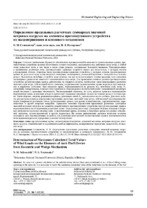| dc.contributor.author | Селивончик, Н. М. | |
| dc.contributor.author | Нестеренко, Н. Л. | |
| dc.coverage.spatial | Минск | ru |
| dc.date.accessioned | 2024-02-06T10:09:35Z | |
| dc.date.available | 2024-02-06T10:09:35Z | |
| dc.date.issued | 2024 | |
| dc.identifier.citation | Селивончик, Н. М. Определение предельных расчетных суммарных значений ветровых нагрузок на элементы противоугонного устройства из эксцентрикового и клинового механизмов = Determination of Maximum Calculated Total Values of Wind Loads on the Elements of Anti-Theft Device from Eccentric and Wedge Mechanism / Н. М. Селивончик, Н. Л. Нестеренко // Наука и техника. – 2024. – № 1. – С. 33-45. | ru |
| dc.identifier.uri | https://rep.bntu.by/handle/data/140899 | |
| dc.description.abstract | Согласно требованиям Правил по обеспечению промышленной безопасности грузоподъемных кранов, противоугонные устройства должны обеспечивать останов последних, находящихся под действием силы ветра, в любой точке рельсового пути, в том числе в месте стыка рельсов, соединяемых боковыми планками. Рекомендованные к применению различные типы противоугонных крановых устройств имеют ряд недостатков, о которых писали в предыдущих статьях. Известны также противоугонные крановые устройства, у которых останов грузоподъемных кранов на рельсовом пути осуществляется стопорным эксцентриком, взаимодействующим с поверхностью головки рельса. Надежность подобных устройств недостаточна, так как из-за постоянного усилия пружины сила сцепления эксцентрика с рельсом не зависит от изменяющейся силы ветра. Для проведения силового расчета противоугонного устройства грузоподъемных кранов, работающих на открытом воздухе, необходимо знать максимальное расчетное значение силы ветра, действующей на его элементы, удерживающие грузоподъемные краны на рельсах при нахождении в нерабочем состоянии. При движении крана, перемещающегося по рельсам под действием силы ветра Pw, эксцентрик, поворачиваясь, передает силу давления со стороны рельса на двуплечий рычаг, соединяющий эксцентриковый механизм с клиновым механизмом. Эксцентриковый механизм, по сути, является приводом вертикального перемещения клина, вследствие которого происходят замыкание клещевого захвата на головке рельса и останов крана. Таким образом, энергия, развиваемая краном, двигаемым силой Pw, используется на его останов. Для этого в статье рассмотрены вопросы определения предельных расчетных значений силы ветра, действующей на суммарные боковые поверхности различных типов грузоподъемных кранов, при разных климатических, аэродинамических, вероятностных и других ветровых нагрузках. Приведена методика определения предельных расчетных суммарных значений ветровых нагрузок на элементы разработанного противоугонного устройства для грузоподъемных кранов, перемещающихся по подкрановым рельсовым путям. Определены расчетные суммарные боковые площади и ветровые нагрузки на мостовые опорные одно- и двухбалочные краны, козловые и башенные краны для разных исполнений, пролетов, грузоподъемностей и других параметров. На основе выполненных расчетов возможно создание модельного ряда противоугонных устройств для различных конструкций грузоподъемных кранов, перемещающихся по подкрановым рельсам, при разных условиях эксплуатации. | ru |
| dc.language.iso | ru | ru |
| dc.publisher | БНТУ | ru |
| dc.title | Определение предельных расчетных суммарных значений ветровых нагрузок на элементы противоугонного устройства из эксцентрикового и клинового механизмов | ru |
| dc.title.alternative | Determination of Maximum Calculated Total Values of Wind Loads on the Elements of Anti-Theft Device from Eccentric and Wedge Mechanism | ru |
| dc.type | Article | ru |
| dc.identifier.doi | 10.21122/2227-1031-2024-23-1-33-45 | |
| local.description.annotation | To carry out a power calculation of the anti-driveaway device (from now on referred to as – AD) of lifting cranes operating in the open air, it is necessary to know the maximum calculated value of the wind force on the elements of the AD According to the requirements of the Rules for ensuring the industrial safety of load-lifting cranes, anti-theft devices must ensure stopping of the latter, which are under the influence of wind, at any point on the rail track, including at the junction of rails connected by side bars. The various types of anti-theft crane devices recommended for use have a number of disadvantages, which have been written about in previous papers. Anti-theft crane devices are also known, in which the stop of lifting cranes on the rail track is carried out by a locking eccentric interacting with the surface of the rail head. The reliability of such devices is insufficient, since due to the constant force of the spring, the adhesion force of the eccentric to the rail does not depend on the changing wind force. To carry out a power calculation of the anti-theft device for cranes operating in the open air, it is necessary to know the maximum calculated value of the wind force acting on its elements that hold the cranes on the rails when the cranes are inoperative. When a crane moves along rails under the influence of wind force Pw, the eccentric, turning, transmits the pressure force from the rail to the double-arm lever connecting the eccentric mechanism to the wedge mechanism. The eccentric mechanism is essentially a drive for the vertical movement of the wedge, as a result of which the pincer clamp closes on the rail head and the crane stops. Thus, the energy developed by the crane, driven by the force Pw, is used to stop it. For this purpose, the paper deals with the issues of determining the maximum design values of the wind force acting on the total lateral surfaces of various types of cranes under different climatic, aerodynamic, probabilistic and other wind loads. A methodology is given for determining the maximum calculated total values of wind loads on the elements of the developed anti-theft device for lifting cranes moving along crane rail tracks. The calculated total lateral areas and wind loads on bridge support single- and double-girder cranes, gantry and tower cranes for various designs, spans, load capacities and other parameters have been determined. Based on the calculations performed, it is possible to create a model range of anti-theft devices for various designs of load-lifting cranes moving on crane rails under various operating conditions. | ru |

